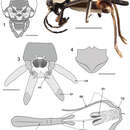Differential Diagnosis
provided by EOL authors
The superfamily Tridactyloidea can be differentiated from all other basal Caelifera by the following characters: [1] metatarsus reduced to a single tarsomere; [2] male paraproct with highly sclerotized basal hook-like process and distal cerciform lobes (secondarily lost in Cylindrachetidae); and [3] presence of abdominal repugnatorial glands (Heads 2010). Other characters traditionally used to define the superfamily are also present in Tetrigidae and may united these two groups (see "Evolution & Systematics" section).
Phylogenetic Relationships
provided by EOL authors
Tridactyloidea share several morphological characters in common with the Tetrigidae, namely: [1] pro- and mesotarsi with only two tarsomeres; [2] absence of arolia; and [3] the pronotum connected directly to the prosternum by means of a precoxal bridge. Moreover, male tetrigids also possess a simple subgenital plate lacking styli and formed from the ninth abdominal sternite, as in Tridactyloidea. In both groups, the tegmina are markedly reduced or entirely absent and, when present, the hind wings always have M closely associated or fused with R for most of its length and Cu deeply forked (branching near the wing base). In addition, the anal lobe of the hind wing is typically large and well-developed, with numerous unbranched anal veins.
Morphological evidence suggests a relationship between Tridactyloidea and Tetrigidae (Heads 2010), though to date, molecular studies (e.g. Rowell & Flook 1998; Flook et al. 1999). have failed to resolve a tridactyloid+tetrigid clade. Clearly, more research is needed to resolve the phylogenetic relationships of these groups (see Heads 2010 for more detailed discussion of the conflict between morphological and molecular data with respect to the phylogeny of basal Caelifera).
Tridactyloidea Brullé, 1835
provided by EOL authors
Members of the superfamily Tridactyloidea are generally small, obscure orthopterans of cryptic habits, characterised by their highly derived morphology, which is remarkably convergent on that of certain Grylloidea. Indeed, the tridactyloids were historically classified with the true mole crickets in the family Gryllotalpidae (e.g. Audinet- Serville 1838; Tillyard 1926; Tindale 1928), though their caeliferan identity was demonstrated beyond any doubt by Ander (1934). In terms of their taxonomy, the Tridactyloidea are one of the best known of the basal Caelifera, having been the focus of numerous careful revisionary studies by the late Kurt K. Günther (e.g. 1969, 1972, 1977, 1989, 1990, 1991, 1992, 1994a,b, 1995).
The superfamily as presently defined (sensu Heads, 2010) includes three families: Cylindrachetidae Giglio-Tos, 1914 (sandgropers); Ripipterygidae Ander, 1939 (ripipterygids); and Tridactylidae Brullé, 1835 (pygmy mole crickets). Monophyly of the group is supported by a number of morphological characters including: the subgenital plate simple, lacking styli and formed from the ninth abdominal sternite in both sexes; development of abdominal repugnatorial glands; metatarsus reduced to a single tarsomere; and males with a bipartite paraproct, bearing highly sclerotized basal hooks and distinctive distal cerciform lobes (lost in Cylindrachetidae) (see Heads 2009, 2010).
Tridactyloidea: Brief Summary
provided by wikipedia EN
Tridactyloidea is a superfamily in the order Orthoptera. The insects are sometimes known as pygmy mole crickets but they are Caelifera and not members of the mole cricket suborder Ensifera, unlike the true mole crickets, the Gryllotalpidae. It is composed of three families that contain a total of about 50 species. Insects in this superfamily can be 4 to 9 millimeters in length and generally have short antennae and long wings. They live along the banks of bodies of water in tropical areas and are good swimmers and jumpers. Fossils of this subfamily have been found in Siberian deposits dating back to the Cretaceous.
- license
- cc-by-sa-3.0
- copyright
- Wikipedia authors and editors

